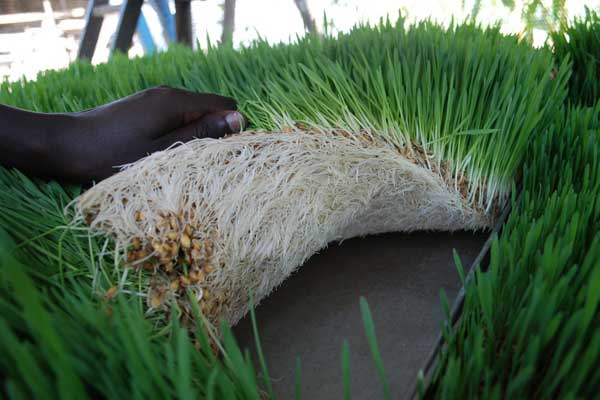Hydroponics in Kenya: Childhood best friends Wachira Mwangi and Samuel Mbugua are teaching farmers a technique that may sound like the stuff of science fiction — growing crops without the use of soil and making a tidy sum out of it.
After a series of boring jobs and failed businesses the 26-year old University of Nairobi-trained biochemists tried to rear pigs early last year but the venture proved too expensive for the fresh graduates.
“We just wanted to keep a few pigs and see how it goes,” says Wachira, “but our biggest problem was the cost of feeding them. That was when my best friend Sam suggested that we grow our own fodder using a rare technology known as hydroponics”.
Hydroponics is the process of growing crops without the use of soil.
How my four dairy cows give me Sh. 135,000 per month
The technique avoids soil to speed up growth while avoiding plant diseases.
“What grows normally on soil for 21 days can take only six days if grown using the hydroponics technology,” says Mbugua.
You can grow pretty much anything using hydroponics, but Mbugua and Wachira decided to grow livestock fodder because it not only saves space and time, but it is also cost-effective in pig farming.
After months of research, the pair started the business in July last year with a capital of Sh50,000. They used the money to fence the quarter acre plot belonging to Mbugua’s parents and bought 15 piglets to experiment with. They also acquired material to put up the required structures as well as barley seeds.
Hydroponics in Kenya: LIMITED SPACE
The pilot project worked so well, so much that farmers began trickling to their farm in Mwiki to be trained on how to grow hydroponic fodder.
So exactly how does the hydroponics technology work?
It works well for livestock farmers with limited space, time and resources because all a farmer requires is 45 cubic metres of space. For example a farmer with 15 cows will require only 5x3x3 metre (45 cubic metres) structure to grow enough fodder for all livestock.
“We spread the barley seeds evenly on aluminium trays and leave them to sprout, only watering them three times a day. In six days, you will have a network of roots and shoots and a mat of barley grass which is now ready for consumption by livestock,” says Mbugua.









hello guys can you pliz connect me with this guy who build hydroponic trays am based in ruiru and i dont have thir contacts pliz
Wachira Mwangi and Samuel Mbugua
Where can I find this guy
Kindly connect me with these guys, aam interested in the technology.my email is :[email protected]
could i have their contacts please [email protected], 0716810232 am in ruai
For those who want to be trained on how hydroponics works can follow me through my email johnnzioka35 @gmail.com
Am a director in hydroponics farming any customer needs assistanc
how can one get in touch with thus guys for training?
How do I get this system?
Hallow where can I get this seeds
Need to learn more about this hydroponic farming.my email [email protected]
Kudos mwalimu sam am also enjoying the fruits of what you taught me.
Please could you share the farmers contacts?
Good innovation. Please get me your telephone contact
please let me have your contact, i would like to attend the training
regard
Kagonia
please let me have contact for hydroponics guy in mwiki. I would like to attend their training
Would like to get your phone ni plz coz huku mashinani network ya internet ni noma. Nko ukambani
Nice job .please send me your number so as to communicate with you send
Very much interested. Am from the western part of Kenya. My contacts is 0704611731 or [email protected]
How can I reach you guys?
That’s cooool,how about the training in hydroponics, interested